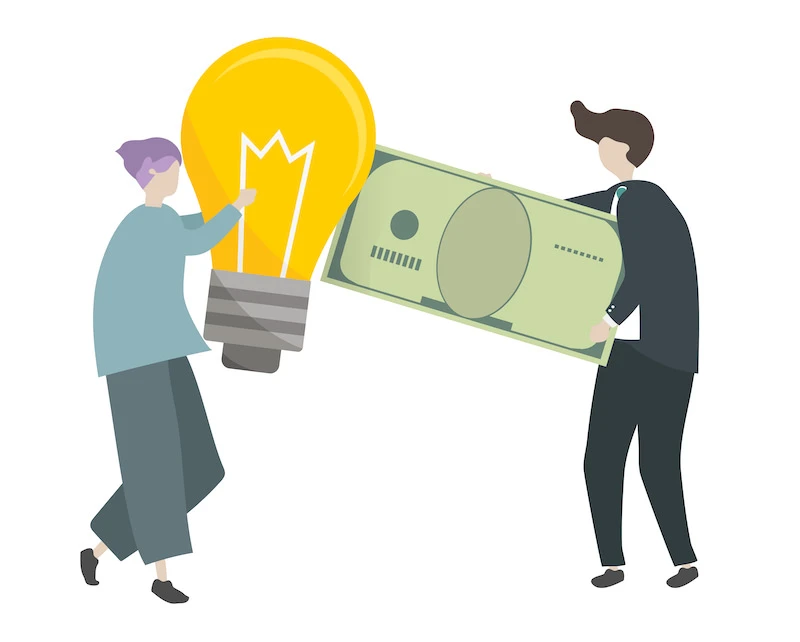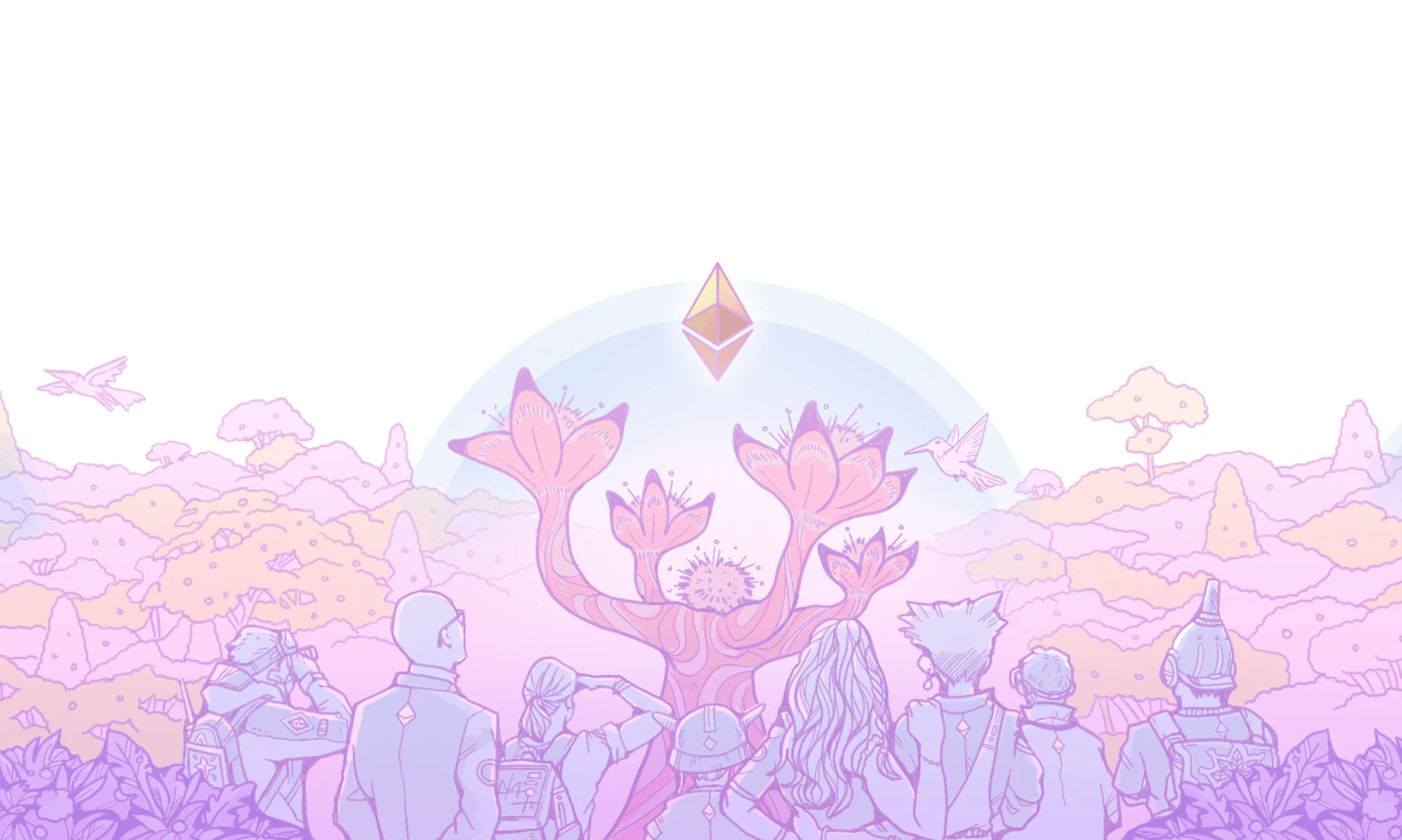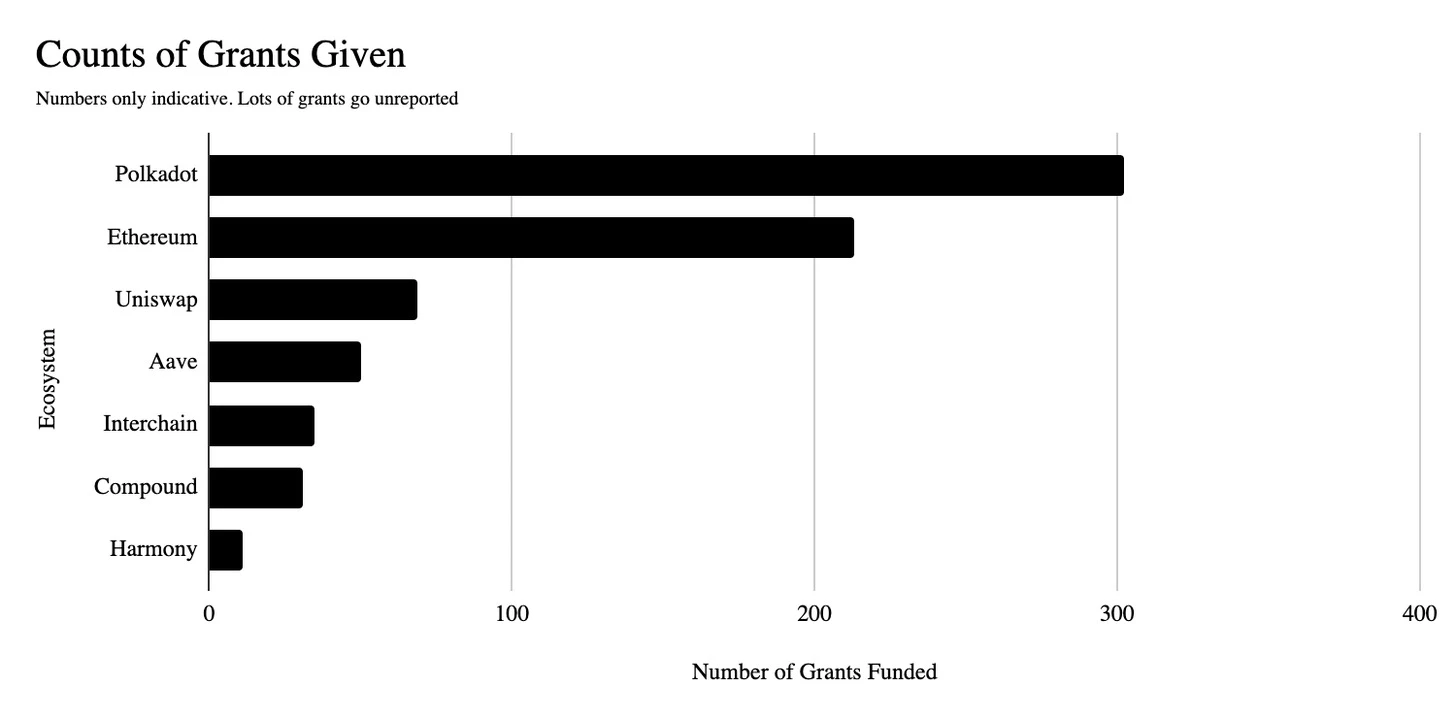
first level title
How to understand Grant?
Grant can be understood as a financial incentive plan launched by each project to continue the vitality of the project. Unlike venture capital funds in the traditional Internet world, eco-funds usually have no external capital. Grant funds usually come from protocol revenue or part of the protocol’s native tokens, which are reserved by the founding team and allocated for new talent funding.
Open branches and leaves for the blockchain ecology
In the Web3 era, the major public chains and protocols are still in a state of separatism. For the public chain, after the initial technical story is told, the follow-up efforts of the ecology become the determining factor of the vitality of the public chain project.
In fact, the launch of the Grant funding program provides strong support for the creation of the next-generation network ecosystem, which not only meets the needs of the blockchain network, but also ensures the sustainability of the ecology.
Another Alternative to Web3er Slash Life
But Grants advantages dont stop there. The existence of Grant also provides an excellent template for decentralized collaboration.
The Grant needs to be distinguished from the millions of venture capital funds. The former is a smaller and more beautiful financial incentive plan with more trivial tasks and a clearer scope. The threshold for participation is also lower. It is not only for team organizations, but also for Also geared toward individuals; not limited to professional developers, but also Web3 enthusiasts.
Maybe you don’t need to have a mature product worthy of starting a business, you don’t need to have a professional team, you just need to be able to solve a specific application problem, such as only being able to develop an SDK, etc., or to be able to shoot a publicity video capabilities. If you do these things alone, you may not be able to generate income, but as long as it is beneficial to the community, you can also apply for Grant to maintain your income.
TinTinLand in Dialogue with Web3 slash youth: blockchain, more than one way of workingIn interviewed two developers who have applied for Grant experience, they deeply realized that the significance of Grant is greater than we imagined.
For developers who are scattered all over Web3 and working alone, Grant may be a part-time job with more freedom of time, and perhaps in the near future, the number of Grants you can obtain on various protocols will become more important than your academic qualifications. Good credentials, after all, your ability to work is publicly visible on-chain. Even, maybe you can find your own career direction through Grant. For those who want to start their own Web3 projects, Grants experience also reduces the cost of experimentation. In the past, the premise of entrepreneurship financing was to convince a group of seed round investors to believe in your ability, but now, these people who have reviewed your Grant’s work contributions are obviously more familiar with your ability than venture capital funds who are completely unfamiliar with you.
New options for transitioning from Web2er to Web3
In fact, for those developers who are still eager to try at the gate of Web3, Grant is also a transitional choice.
According to a Decentralised post, about 340,000 developers will enter this circle in 2021, but there are only about 18,000 monthly active developers in the Web3 system, which is the highest level ever recorded. If Web3 is going to take hold around the world, obviously we need to get more developers on board.
Developers have different reasons for not joining Web3. MakerDAO’s sustainable ecosystem expansion core department recently released a report, concluding that the recognition of technology and value will eliminate many people; in addition, some negative news in the Web3 field, such as scams, hacking and Ponzi, All are reducing the reputation of the entire Web3 industry. Developers find that it is risky to completely transition to Web3, which prevents such people from fully transitioning to this industry.
Grant, on the other hand, has become a new choice for such a transition. The time and place for completing the Grant plan can be allocated by yourself, which provides a buffer stage of understanding for developers who are not yet willing to be All in Web3. How to cultivate your own recognition of the value of Web3 and devote yourself to it may be the best way to reverse prejudice.
reading instructions
Therefore, Tintinland also organizes a more comprehensive Grant plan to share with readers. In the process of organizing, we also have the following tips for your reference:
(1) In the early stage of project development, the amount of Grant and the choice of bounty tasks will obviously be more than those in the later stage. After Grant has been in operation for a period of time, some projects will choose to close, and some will use Grant as a long-term plan. The items of the Grant entry are beyond the scope of this article.
(2) The bonuses of some large companies or project teams are usually very sought-after, so entrepreneurs can also consider the bonus plans released by some emerging blockchain networks. In the vast majority of Grant applications, those with successful experience in other Grant applications will receive more points. Once the product concept has been verified on a certain chain, it will be easier to raise funds and expand to other chains.
(3) Different projects have subtle differences in the definition of Grant. Some projects include venture capital funds and ecological incentive funds in Grant, while some projects will strictly distinguish them. This article only sorts out Grant in a narrow sense, that is, for a wider range of people, Grant funding programs with smaller amounts.
first level title
secondary title

Ethereum’s “Ecosystem Support Program”
ESP (ecosystem support program) is the fund allocation department of the Ethereum Ecological Foundation for the public, supporting open source projects that strengthen the foundation of Ethereum.
ESP has two Grant forms:
Small Grant, which refers to the Grant within US$30,000, has a simplified application and evaluation process, and a decision is made about two weeks after the project is submitted;
Project Grant, which has no funding cap, but requires more careful investigation and a longer decision-making time (around 2 months).
https://esp.ethereum.foundation/
secondary title
Uniswap Distributed Encryption Trading Platform Protocol
Uniswap also benefited from a $100,000 Grant from the Ethereum Foundation. The currently launched UNI Grants Program incentive plan mainly funds Uniswap-related activities and developer education.
secondary title
https://www.notion.so/unigrants/Welcome-to-UNI-Grants-6e3e84967a984a5fb127ae749649ddc9
Aave Liquidity Protocol
A community-led grant program: supporting projects primarily for protocol development, applications and integrations, developer tools, code audits, committees, subcommittees and DAOs serving the Aave ecosystem, community (marketing and education), events and hacks marathon.
According to the amount range, it can be divided into four forms:
< $20,000: Faster grants through only one round of committee review
$20,000-$100,000: Subject to one round of committee review, interview and internal review
$100,000: After a round of reviews and interviews, proposals are required to be voted on in Aaves governance forum for funding
secondary title
Blancer Decentralized Trading Protocol
Balancer Grants (BAL) is a way for BalancerDAO to promote the development of the Balancer protocol and ecosystem. Grant is divided into two parts:
Development Bounty: The bounty amount is from $1k to $75K, and the review process is determined based on a bounty of $5,000. The review criteria are to increase TVL, expand the Balancer ecosystem, and create internal value (create documentation, tools, STK, and other resources to reduce barriers for developers to build on the Balancer protocol.)
secondary title
https://balancergrants.notion.site/Balancer-Community-Grants-23e562c5bc4347cd8304637bff0058e6
Compound Decentralized Lending Protocol
The Compound Grants Program (CGP) is a community grant program initiated by Compound community members in March 2021 with an amount of 5,000 COMP to grow the Compound ecosystem by funding developments on it.
secondary title
https://compoundgrants.org/?ref=blockchaingrants.org
mStable Stablecoin Aggregation Protocol
secondary title
https://github.com/mstable/mStable-dev-grants
Gitcoin Open Source Software Grants Platform for the Ethereum Community
The open source nature of Ethereum has given birth to an interesting new fundraising model: quadratic financing, the main representative platform is Gitcoin. Gitcoin Grants is a quadratic donation platform. When a project receives more donations, the Ethereum Foundation will sponsor more grants accordingly.
secondary title
Curve Decentralized Exchange Pool Protocol
The Curve Ecological Fund mainly includes three parts:
Ecosystem Grant: Aims to encourage and develop Curve, Vyper Language, and the broader DeFi ecosystem. Grants will range from $1,000 to $150,000.
Community Grants: To encourage and grow the Curve community and Curve itself. Grants range from $100 to $2,000 and are paid in CRV.
secondary title
https://news.curve.fi/community-grants/?ref=blockchaingrants.org
Pool together decentralized lottery protocol
Pool togethers long-term community funding plan approved in May 2021, funding includes protocol development, applications and integration, developer tools, marketing and education, referral reward program, committees, subcommittees and DAOs serving the PoolTogether ecosystem, Code audit.
first level title
https://poolgrants.org/82383755c2c8431eade3651ad7de7948
secondary title
Polkadot
Grant is a funding program launched by Polkadots Web3 Foundation in 2018 to help teams with decentralized technology stacks, focusing on software development and research.
It is mainly divided into three parts:
Proposal expenditures are generally for larger projects, such as software development and offline activities, etc., the amount is relatively large, the application and approval process is more complicated, and a certain deposit is required;
Tips are generally for relatively light contributions, such as translation, design, online activities, etc. The application process is simple and the amount is generally small;
The bounty task (Bounty) is specified by the proposer, followed by a dedicated manager.
https://web3.foundation/grants/
image description

secondary title
Flow
secondary title
https://github.com/onflow/developer-grants
NEAR
secondary title
https://near.org/ecosystem/get-funding/
Chainlink Decentralized Oracle Network
The Chainlink Community Incentive Program provides development teams with incentives to develop tools for the Chainlink ecosystem or integrate Chainlink technology. Divided into five prize pools:
Community Incentive Bonuses, awarded to development tools and infrastructure in the Chainlink ecosystem;
Integration bonuses, awarded to projects that provide various technologies and services to the Chainlink network;
Bug bounty program, awarded to developers and security engineers who view Chainlink core code;
Research proposals, awarded to academic researchers to conduct and publish innovative research;
secondary title
https://zh.chain.link/community/grants
DFINITY
secondary title
Solana
secondary title
Filecoin
secondary title
Nervos
secondary title
https://www.nervos.org/developer/grants
Nexus Mutual Decentralized Insurance Protocol
secondary title
https://nexusmutual.gitbook.io/docs/nexus-mutant-community/community-fund/grant-application-process
Oasis
secondary title
https://oasisprotocol.org/grant-programs
Kadena
secondary title
https://github.com/kadena-io/technical-grants
Skale Ethereums native multi-chain network
secondary title
Tezos
The Tezos Foundation Grant is divided into two parts:
Bounty task, that is, the foundation assigns a specific task and a specific amount of reward for the solution;
Free proposals, the topics focus on the development of node tools, developer education, user experience, community training, etc. Proposals are reviewed by the Technical Advisory Committee (TAC).
secondary title
https://tezos.foundation/bounty-program/
Zcash
secondary title
Stacks
Stacks grant types include milestone grants, community support grants, subject matter expert residency, and various other forms of support.
Developer Grant: Including the first development and follow-up development. The former is aimed at funding novices, with funding ranging from $0 to $25,000. Once an initial grant has been awarded, STACKs encourages developers to apply for open source development, repeat/follow-up grants. Grants range from $25,000 to $250,000.
Community grants: mainly support community education, community activities, and activities of national chapters, with funds ranging from $0 to $10,000.
Wishlist Grant: To realize some ideas put forward by the community.
secondary title
https://github.com/stacksgov/Stacks-Grant-Launchpad
OceanDAO
OceanDAO provides community grants curated by OCEAN holders to grow the ocean ecosystem. Funds can be used to build software that uses Ocean, unlock data, and promote and improve OceanDAO itself. From January 2021 to the present until the 21st round. Also determined by community vote. The upper limit of the bounty amount will be determined according to the number of Grants received. If it is the first time, the upper limit is 3,000 US dollars; if more than 1 has been completed, the upper limit is 75,000 US dollars; if more than 2 completions, the upper limit can be increased to 15,000 US dollars.
secondary title
Mina
Mina Grant mainly includes technical support and community donations. The bounty task allocates funds according to the task type. The higher the difficulty factor, the higher the reward. There are three types of tasks: front-end product, agreement project, marketing and community project.
Such as product front-end, with a monthly budget of at least 40,000 Mina; browser wallet, with a monthly budget of at least 80,000 Mina; or by acting as an ambassador, creating content, and other initiatives to help build and develop Mina’s community, with a monthly budget of at least 4,000 Mina.
All grants are subject to approval by the Foundation O(1) Labs.
https://minaprotocol.com/grants










